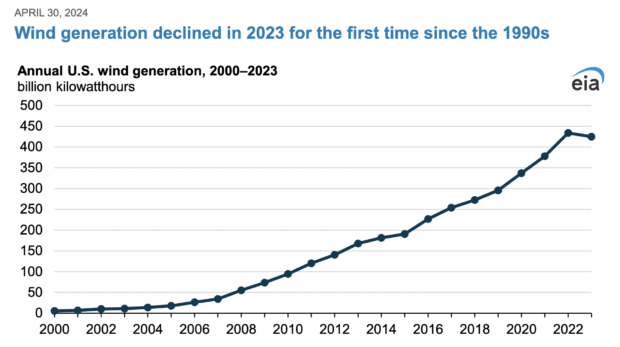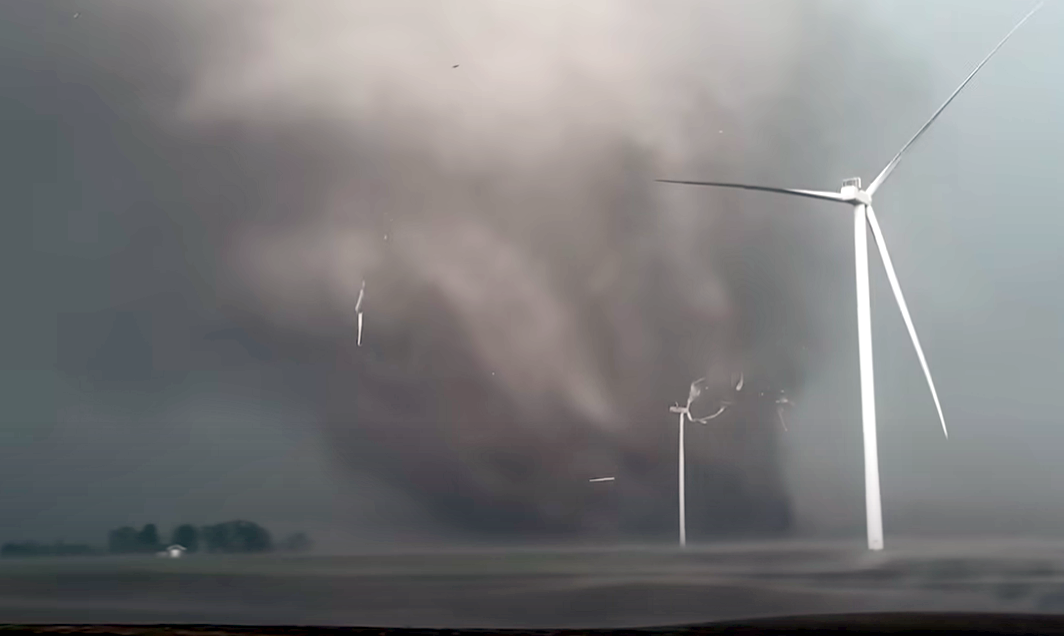Gamblers bet on anything with favourable odds, but betting on wind and sunshine for your power needs means the house always wins – with you sitting freezing or boiling in the dark.
America has poured hundreds of $billions in subsidies to chaotically intermittent wind and solar and, predictably enough, the grand wind and solar bet shows no sign of ever paying off.
Indeed, while installed wind power capacity increases (along with a commensurate increase in the subsidies required to build that capacity) the per unit output continues to slide.
Whatever the opposite of ‘bang for buck’ is, America’s taxpayers and power consumers are on the receiving end of it. As these pieces from Nick Pope and Paige Lambermont detail below.
‘Gambling With The Grid’: New Data Highlights Achilles’ Heel Of One Of Biden’s Favorite Green Power Sources
Daily Caller
Nick Pope
4 May 2024
New government data shows that wind power generation fell in 2023 despite the addition of new capacity, a fact that energy sector experts told the Daily Caller News Foundation demonstrates its inherent flaw.
Wind generation fell by about 2.1% in 2023 relative to 2022 generation, despite the 6 gigawatts (GW) of wind power capacity that came online last year, according to data published Tuesday by the U.S. Energy Information Administration (EIA). That wind power output dropped despite new capacity coming online and the availability of government subsidies highlights its intermittency and the problems wind power could pose for grid reliability, energy sector experts told the DCNF.
The decrease in wind generation is the first drop on record with the EIA since the 1990s; the drop was not evenly distributed across all regions of the U.S., and slower wind speeds last year also contributed to the decline, according to EIA. The Biden administration wants to have the American power sector reach carbon neutrality by 2035, a goal that will require a significant shift away from natural gas- and coal-fired power toward wind, solar and other green sources.
“Relying on wind power to meet your peak electricity demands is gambling with the grid,” Isaac Orr, a policy fellow at the Center of the American Experiment who specializes in power grid-related analysis, told the DCNF. “Will the wind blow, or won’t it? This should be a moment where policymakers step back and consider the wisdom of heavily subsidizing intermittent generators and punishing reliable coal and gas plants with onerous regulations.”
Between 2016 and 2022, the wind industry received an estimated $18.6 billion worth of subsidies, about 10% of the total amount of subsidies extended to the energy sector by the U.S. government, according to an August 2023 EIA report. Wind power received more assistance from the government than nuclear power, coal or natural gas over the same period of time.
“This isn’t subsidies per kilowatt hour of generation. It’s raw subsidies. If it were per kilowatt hour of generation, the numbers would be even more extreme,” Paige Lambermont, a research fellow at the Competitive Enterprise Institute, told the DCNF. “This is a massive amount of money. It’s enough to dramatically alter energy investment decisions for the worse. We’re much more heavily subsidizing the sources that don’t provide a significant portion of our electricity than those that do.”
“Policy that just focuses on installed capacity, rather than the reliability of that capacity, fails to understand the real needs of the electrical grid,” Lambermont added. “This recent disparity illustrates that more installed wind capacity does not necessarily correlate with more wind power production. It doesn’t matter how much wind you add to the grid, if the wind isn’t blowing at peak demand time, that capacity will go to waste.”
Wind power’s performance was especially lackluster in the upper midwest, but Texas saw more wind generation in 2023 than it did in 2022, according to EIA. Wind generation in the first half of 2023 was about 14% lower than it was through the first six months of 2022, but generation was higher toward the end of 2023 than it was during the same period in 2022.
In 2023, about 60% of all electricity generated in the U.S. came from fossil fuels, while 10% came from wind power, according to EIA data. Beyond generous subsidies for preferred green energy sources, the Biden administration has also aggressively regulated fossil fuels and American power plants to advance its broad climate agenda.
The Environmental Protection Agency’s (EPA) landmark power plant rules finalized this month will threaten grid reliability if enacted, partially because the regulations are likely to incentivize operators to close plants rather than adopt the costly measures required for compliance, grid experts previously told the DCNF. At the same time that the Biden administration is effectively trying to shift power generation away from fossil fuels, it is also pursuing goals — such as substantially boosting electric vehicle adoption over the next decade and incentivizing construction of energy-intensive computer chip factories — that are driving up projected electricity demand in the future.
“The EIA data proves what we’ve always known about wind power: It is intermittent, unpredictable and unreliable,” David Blackmon, a 40-year veteran of the oil and gas industry who now writes and consults on the energy sector, told the DCNF. “Any power generation source whose output is wholly dependent on equally unpredictable weather conditions should never be presented by power companies and grid managers as safe replacements for abundant, cheap, dispatchable generation fueled with natural gas, coal or nuclear. This is a simple reality that people in charge of our power grids too often forget. Saying that no doubt hurts some people’s feelings, but nature really does not care about our feelings.”
Blackmon also pointed out that, aside from its intermittency, sluggish build-out of the transmission lines and related infrastructure poses a major problem for wind power.
“Wind power is worthless without accompanying transmission, yet the Biden administration continues to pour billions into unreliable wind while ignoring the growing crisis in the transmission sector,” Blackmon told the DCNF.
Another long-term issue that wind power, as well as solar power, faces is the need for a massive expansion in the amount of battery storage available to store and dispatch energy from intermittent sources as market conditions dictate. By some estimates, the U.S. will need about 85 times as much battery storage by 2050 relative to November 2023 in order to fully decarbonize the power grid, according to Alsym Energy, a battery company.
The White House and the Department of Energy did not respond to requests for comment.
Daily Caller
Wind Subsidies Are Rising… but wind power production isn’t rising with them.
Catalyst Independent
Paige Lambermont
21 May 2024
New data recently released by the Energy Information Administration (EIA) shows a decrease in wind power production in 2023. Despite record highs in installed wind capacity and continually rising subsidies production is falling.
Thanks to these subsidies, including the longstanding Production Tax Credit (PTC) and Investment Tax Credit (ITC), and the extensions that these credits received in the Inflation Reduction Act (IRA), subsidies for wind power have seen a dramatic increase over the last decade. The IRA extended these credits through 2025, and replaces them with the new, but similar, Clean Energy PTC and Clean Energy ITC through 2032. It also added provisions to provide even larger subsidies for projects that meet “Environmental Justice” requirements. All of this together will maintain, and increase, both the scope of subsidies for wind, and the impact that those subsidies have on the overall market for electricity.
Will this money do any good for the power grid? Will added investment in renewable sources, particularly wind, lead to any increase in the amount of wind power generated? And will that capacity increase or decrease the resiliency of the grid?
The answer to all of the preceding questions is an emphatic “no” and recent reality bears this out.
The highest installed wind capacity on record was last year, with nearly 150 gigawatts of installed wind capacity in the US.
Even with this record capacity last year, there was also a decline in power generated from wind for the first time. There was 2.1 percent less wind power generated in 2023 than in 2022. This was in part due to slower wind speeds that year, an inherent flaw of wind power. The intermittency of the source also means that sometimes wind power is unavailable when demand is high, but available when it is not, which can also result in less wind power being used.
These aren’t problems that subsidy dollars can solve, they’re inherent to the technology. Despite this, lawmakers have continually tried throwing money at the problem. From 2016 to 2022, the federal government spent approximately $18.7 billion on subsidies for wind power alone. This is a massive amount of money. It’s even more considerable given that wind’s intermittency heavily limits its benefit to reliability.
During that period, wind subsidies were much higher than the subsidies for any of the conventional power sources: natural gas, coal, and nuclear. Specifically, the wind subsidies were about 2.5 times greater than both coal subsidies and refined coal subsidies, and greater than both coal and refined coal subsidies combined. The wind subsidies were also about double the subsidies for natural gas and petroleum liquids and about 6.5 times greater than nuclear subsidies.
Renewables received 46 percent of overall power subsidies, despite constituting a very small portion of overall power generation.
This isn’t subsidies per kilowatt hour of generation. It’s total subsidies. If it were per kilowatt hour of generation, the disparity would be even more extreme given how much more output conventional sources have. To be clear, policymakers shouldn’t be increasing the subsidies for reliable sources to account for this disparity. The way to fix power markets is to subsidize everything less (ideally not at all). The solution to grid reliability problems is certainly not to subsidize the least reliable sources the most.
Decreasing wind generation makes wind’s power production limitations more obvious. It also emphasizes what many reliability advocates have been saying for years: government meddling in electricity markets in favor of unreliable sources will have consequences for reliability as money is funneled away from what works and toward what does not.
As a general matter, lawmakers should stop subsidizing energy sources. To protect reliability, lawmakers should look to repeal the IRA extensions of wind and solar tax credits as a first step toward repairing the damage that these subsidies have done to electricity markets.
Catalyst





I’m going to say it…. the ultimate, sinister agenda behind liberal-driven wind and solar is blackouts and chaos.
What, no drop off but growth during COVID?
I don’t suppose it ever occurred to these windfarm geniuses that extracting ever-increasing quantities of kinetic energy from the weather system might have some effect on the availability and distribution of the remaining energy…
Er…silly question!
US Federal subsidies per kWh (not counting state subsidies) in 2018 (the latest year available when I wrote “Where Will We Get Our Energy?”) for coal were 3.55 times greater than for nuclear, only 63% as much for hydro, 103 times more for wind, and 263 times more for solar. The Federal government made a profit on gas with a “subsidy” of -0.066¢/kWh.
Can we post more hardcore pics of the windmills? I like the burning ones the most
We need videos too of these things malfunctioning
you must thank Al Gore , Barrack Obama for this fiasco